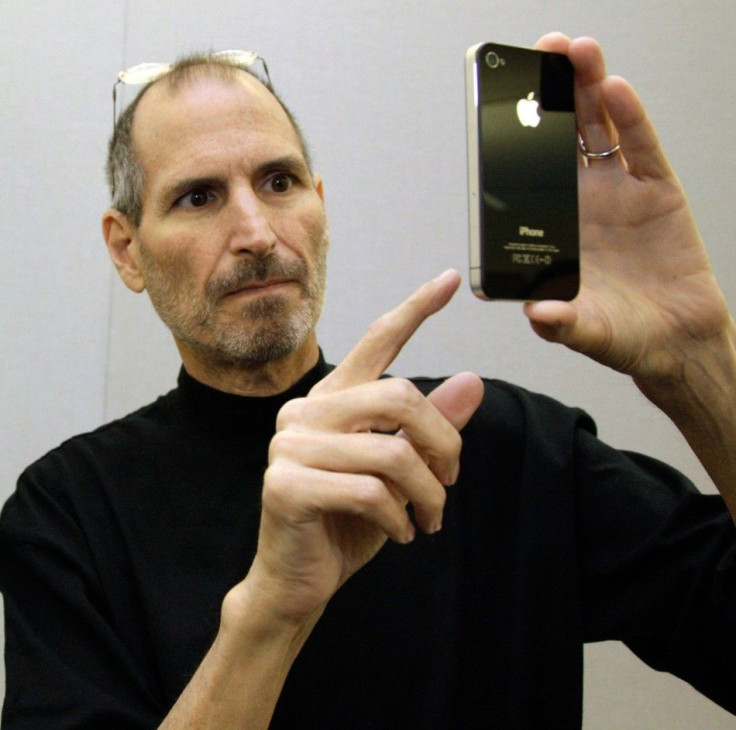Apple Patents App Switching During Calls: Steve Jobs' War on Android Continues

Apple won a key smartphone patent from the U.S. Patent and Trademark Office this week. It describes the general ability to switch to other applications while maintaining a phone call. The patent victory is yet another blow to Google's Android, an operating system that Steve Jobs deemed a stolen product from Apple.
Apple hopes to destroy Android by cutting off its resources -- namely, Apple's inventions and designs. Like the company's other patents, Apple used extremely general language in describing the process for switching between a phone call and an app in order to prevent competitors from using the same feature in the same way. Here's a brief list of features from Apple's newest patent:
- During a call on a portable electronic device with a touchscreen, the phone application display shows a menu button or an icon, which then replaces the first interface with a menu of applications icon including an icon for the phone application and an icon for a non-telephone application.
- When a user touches another icon, the phone then displays that corresponding app interface on the display while maintaining the phone call. The interface features a phone app icon that isn't displayed when there's no ongoing phone call.
- When a finger gesture touches the switch application icon, the display is replaced with the corresponding app interface within the phone application, all while the call is maintained.
While the process seems simple and specific, Apple's lawyers have thrown competing developers a curveball. If they try to recreate this feature in their own smartphones, they'll be infringing on Apple. Now, mobile operating system developers like Android and Microsoft must find a non-infringing way to build a similar system.
On Monday, the International Trade Commission ruled in favor of Apple, giving the Cupertino, Calif.-based company a key victory over HTC, which will impose an import ban on some of the company's products. However, HTC's violation is only limited to one patent, and the company says it will resume business as usual, despite the advent of a ban coming on April 19, 2012.
We are gratified that the commission affirmed the judge's initial determination on the '721 and '983 patents, and reversed its decision on the '263 patent and partially on the '647 patent. We are very pleased with the determination and we respect it, said Grace Lei, general counsel for HTC. However, the '647 patent is a small UI experience and HTC will completely remove it from all of our phones soon.
Apple won 31 new patents in November, including a patent for an crack-proof glass invention, and an extremely broad reissued patent originally filed by Xerox in 1998 for location-based services. That patent predated mobile apps and major social networks, and described a system that displays information specific to where the device is, and a system that receives location information from at least one object and specifies the location of the site to the device user. Then, a transceiver sends the location information over a distributed network (i.e. the Internet) to a destination, which gets location-specific information in return.
Writer Erik Sherman summed it up:
If you thought that Google, Samsung, HTC and others were already depressed over the legal success Apple has had in fighting Android, it's now officially worse.
Unless these companies can create their own inventions and file appropriate patents for them, Apple will continue to boss around Android in the patent war.
Here is the official patent description for Apple Patent No. 8,082,523, called Portable electronic device with graphical user interface supporting application switching:
A method, comprising: at a portable electronic device with a touch screen display: displaying on the touch screen display a first user interface for a phone application during a phone call; detecting activation of a menu icon or menu button during the phone call, in response to detecting activation of the menu icon or menu button, replacing the first user interface for the phone application with a menu of application icons including an icon for the phone application and an icon for a non-telephone application; maintaining the phone call while displaying the menu of application icons on the touch screen display; detecting a finger gesture on an application icon in the menu of application icons other than the phone application icon; in response to detecting the finger gesture on the application icon other than the phone application icon, displaying a corresponding application user interface on the touch screen display while continuing to maintain the phone call and modifying the corresponding application user interface to include a switch application icon that is not displayed in the corresponding application user interface when there is no ongoing phone call; detecting a finger gesture on the touch screen display on the switch application icon; and in response to detecting the finger gesture on the switch application icon, replacing display of the corresponding application user interface with the first user interface for the phone application while continuing to maintain the phone call.
© Copyright IBTimes 2024. All rights reserved.






















